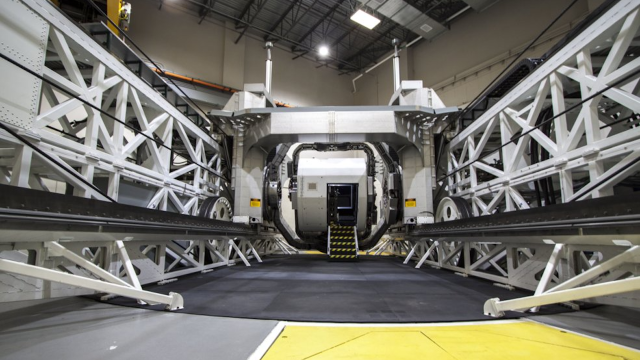The U.S. Navy is unleashing its monstrous Kraken device on NASA, allowing the space agency to use the dizzying machine for an upcoming study that could help it mitigate the effects of spaceflight on astronauts.
A group of 24 active duty service members will get to ride the 15.24 m-long machine for 60 minutes, spinning like a dirty sock inside a washing machine at accelerations up to three times the force of gravity to simulate what astronauts experience during spaceflight, NASA announced on Wednesday. The torturous ride is meant to help scientists come up with ways to reduce symptoms such as dizziness, nausea, and vertigo once astronauts exit their spacecraft.
Sometimes the hardest part about going to space is getting there. Astronauts can experience severe motion sickness during their launch to space, as well as on their way back to Earth. “Shortly after liftoff in the space shuttle, I felt like I was on a merry-go-round as my body hunted for what was up, down, left, and right,” NASA astronaut Douglas Wheelock, said in the NASA statement.
The Kraken can simulate different types of flight “to disorient occupants through sudden shifts in roll, pitch, and yaw, superimposed onto horizontal and vertical lurches,” NASA wrote. It sounds like the worst type of amusement park ride you’ve ever been on, but this ride is a necessary evil.
For the upcoming study, the Kraken will be on a spaceflight-specific setting, as opposed to settings meant for jet pilots, allowing NASA scientists to study whether certain head movements could help ease astronauts’ motion sickness after their flight, according to NASA. “With the ability to move six directions on its axis, the device can simulate complex flight scenarios that are difficult to recreate on Earth, including landing scenarios that could induce vertigo and nausea,” Laura Bollweg, who manages astronaut health research at NASA’s Johnson Space Centre in Houston, said in the statement.
After the 24 volunteers exit the Kraken, 12 of them will perform prescribed head turns and tilts while wearing video goggles to track their head and eye movements. The goggles measure how much the participants blink, as well as changes to their heart rate, and other indications of their motion sickness. The volunteers will also answer questions about how they are feeling.
The other half of the group will not perform the head movements, but all 24 volunteers will be asked to perform four tasks: testing their balance while standing on foam with eyes open and closed, walking for 10 metres to test their speed, testing their endurance on another two-minute walk, and how long it takes for them to finish a standing and walking test that includes stepping over an obstacle. These may seem like easy tests, but the tasks will surely be much harder to perform after that 60-minute ride aboard the Kraken.
“Anecdotes from astronauts suggest that performing slight head movements helps them recover a sense of balance more quickly,” Michael Schubert, a neurophysiologist at Johns Hopkins University, and lead author of the study, said in a statement. “Tests with the Kraken will allow us to rigorously determine what head movements, if any, help astronauts to quickly recover their sense of balance.”
